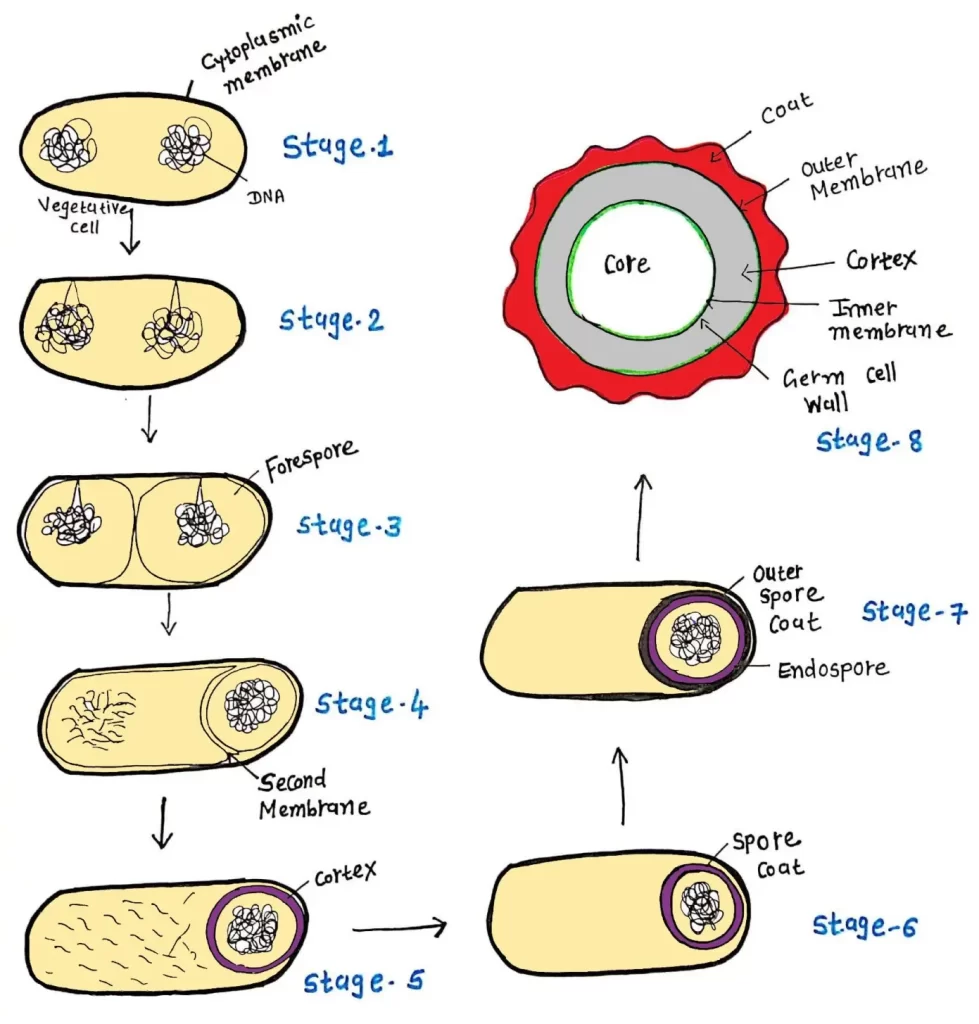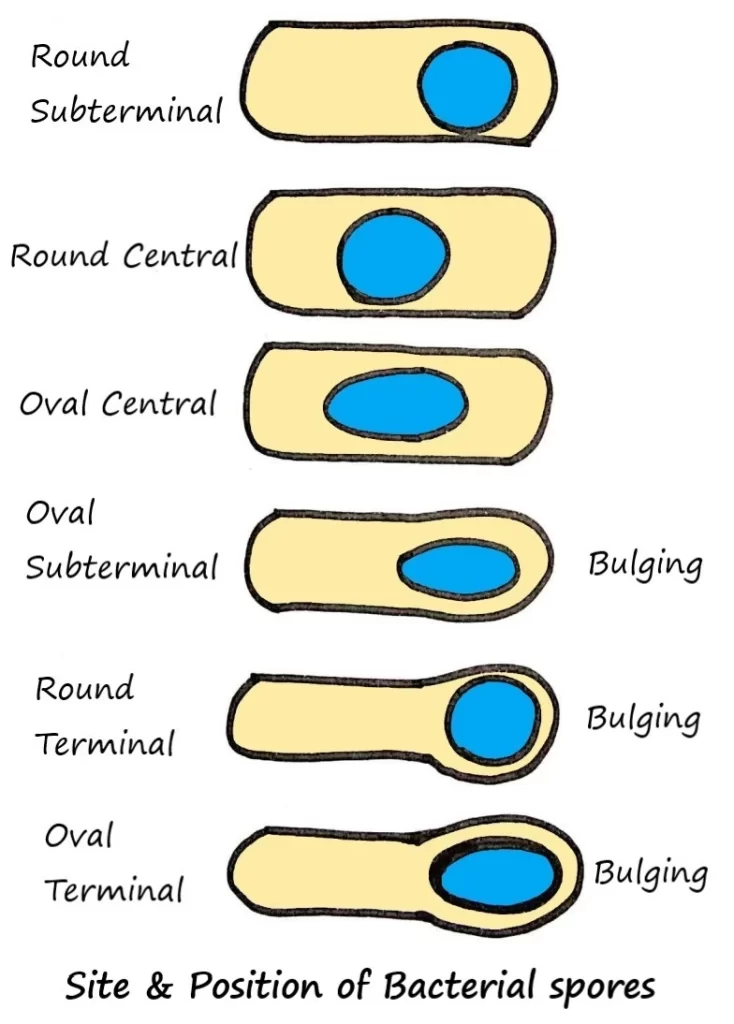
Have you ever wondered how bacteria survive in the harshest conditions—extreme heat, dehydration, radiation, and even toxic chemicals? The secret lies in their ability to form endospores, specialized structures that act as a bacterial survival shield.
When essential nutrients like carbon or nitrogen become scarce, certain Gram-positive bacteria—such as Clostridium and Bacillus—undergo a transformation, creating highly resistant, dormant cells known as endospores. These tough structures allow bacteria to pause their life cycle and reactivate once conditions improve.
In this post, we will explore:
✔️ How endospores form (sporulation process)
✔️ Why they are so resistant
✔️ How they germinate back into active bacteria
✔️ Their role in microbiology, sterilization, and even bioterrorism
Let’s dive into the fascinating world of bacterial endospores and discover what makes them one of nature’s most durable life forms!
Table of Contents
ToggleHow bacteria survive in adverse condition?
- When essential nutrients are deficient, certain gram-positive bacteria (genera Clostridium and Bacillus) form specialized “Resting” cells which are known as
- Endospores are highly resistant dehydrated bacterial cells having thick walls and some additional protective layers.
- They are formed internal to the bacterial cell membrane.
- When they are released into the environment, they can survive extreme heat, lack of water, and even exposure to many toxic chemicals and radiation.
How endospores are formed?
- The process of endospore formation inside a vegetative cell (normal growing cell) is known as sporulation or sporogenesis.
- Bacterial spores formed within the mother cell, are called endospores and remaining part of the bacteria is called the sporangium.
- It takes several hours after exposure in unfavourable environment.
- This happens when a growing healthy bacterium finds insufficiency or unavailability of key nutrients like carbon or nitrogen.
Endospores can remain in a dormant state for up to 50 years, lying in wait like nature’s tiny time capsules. The moment they encounter favorable conditions, they spring back to life, germinating into active bacteria and restarting their biological journey! 🌱✨
Stages of Endospore Formation

Fitz-James & Young (1969) examined the process of endospore formation in Clostridium with the help of Electron microscope.
This process is explained in Eight stages as follows:
• Under unfavourable environmental condition, when there is no cellular division and there is lack of ATP or energy in the cell, a special gene becomes active.
Stage 1: The genetic material of vegetative bacteria replicates.
Stage 2: DNA arranges toward the long axis of the mother cell.
Stage 3: Cytoplasmic membrane folds inside to form forespore.
Stage 4: Cytoplasmic membrane grows and engulfs forespore. DNA gets dissolved.
Stage 5: A cortex (outer layer) of calcium ions & dipicolinic acid is deposited between the membranes.
Stage 6: Formation of spore coat around endospore. The spore coat is formed by keratin like protein which is impermeable to antibacterial chemical agents.
Stage 7: Maturation of endospore and completion of spore coat.
Stage 8: Release of mature endospore from original cell.
- Generally, a single bacterial cell transforms into a single endospore but in some cases two endospores are also observed from a single cell.
• Spores may be
1.Spherical central.
2. Oval central.
3. Oval subterminal not bulging.
4. Oval subterminal bulging.
5. Terminal spherical bulging.
6. Oval terminal bulging.

Structure of Spores
Bacterial spore is made up of several layers.
From innermost towards the outermost, the layers are:
core → cortex → coat → exosporium.
- The core is the inner most part with the DNA material and is separated from cortex by an inner membrane and the germ cell wall.
- Cortex and the coat layers lie external to the core, and are separated from each other by an outer membrane.
- The outermost layer is known as the exosporium.
Why endospore is a highly resistant structure?
Endospores are highly durable due to following reasons:
(I) Metabolic activities become very low.
(ii) Very few amounts of water.
(iii) Spore coat remains impermeable and protective.
(iv) Lack of active enzymes.
(v) The endospore contains a large amount of an organic acid called dipicolinic acid (DPA), with a large number of calcium ions. DPA protects the DNA from damage.
(vi) Presence of stabilizer compound i.e. Picolenic acid.
- Endospore cannot serve as a source of reproduction because the number of cells does not increase.
- Endospores are immune to the process of heating, freezing, desiccation, chemicals or radiations which can kill the vegetative bacterial cells therefore, endospore is a problem in food industries.
Thus, highly dehydrated endospore core contains only DNA, small amounts of RNA, ribosomes, enzymes, and a few important small molecules which are required for restarting of metabolism later when environment becomes favorable.
So, one question may rise in your mind that how an endospore returns to its vegetative state?
When exposed into favourable conditions for growth, bacterial spores start germination.
GERMINATION OF SPORE
It is the process of conversion of spore into a vegetative cell under favourable environmental condition.
It happens in about 2 hours under ideal conditions.
It is explained in following 3 stages: Activation, Initiation & Growth.
- Activation
• Bacterial spores activate germination only when some agents damage the spore coat.
• Agents like heat (60°C for 1 hour), low pH, compound containing free sulfhydryl, abrasion, etc. damage the spore coat. - Initiation
• Once activated, spore initiates germination.
• Autolysin enzyme destroys outer peptidoglycan layer.
• So, water is taken up and calcium dipicolinic acid gets released with degeneration of many hydrolytic enzymes. - Outgrowth
• Spore coat becomes soft by the uptake of water.
• The cytoplasm of spore swells up due to absorption of salts, nutrients and water.
• Thus, outer spore coat breaks up and the developing cell comes out and starts growing in new vegetative cell.
• Now active biosynthesis takes place and starts cell division.
• Nutrients are required for cell growth.
Sporicidal Agents
Spores are resistant to most of the routinely used disinfectants. Only few sterilization methods are able to kill the spores.
Applied Microbiology
Spores of certain bacteria are used as an indicators for successful sterilization. Absence of the spores after autoclaving or processing in hot air oven suggests proper sterilization.
Example:
1) Spores of Geobacillus stearothermophilus are used as sterilization control for autoclave.
2) Spores of Clostridium tetani are used as sterilization control for hot air oven.
- Spores have also been used as agents of bioterrorism,
Example: Endospores of Bacillus anthracis were used in the 2001 anthrax bioterrorism attack.
